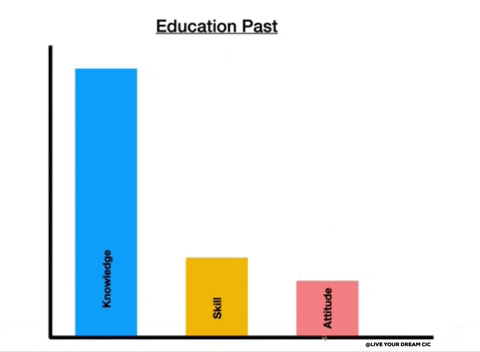Redressing the balance: how and why education should innovate

There is a very common and popular model of learning which says this: In order to learn a student needs knowledge, skills and attitude.
Knowledge gives students a theoretical framework and skills enable students to apply their knowledge in practice. What about attitude?
Attitudes are a set of psychological states and dispositions that include creativity, drive and resilience. Attitude is what gives students the ability not only to face but to embrace challenges. Students with the right attitudes to learning are not plagued by anxieties or a fear of failure, but instead set and aim to achieve valuable goals that facilitate their academic growth.
Conversely, students without the right set of attitudes to learning are unable to learn effectively. They tend to give up or cheat when subjects become challenging. They tend to lack emotional regulation, may well be disruptive in class or else lack the belief that they have the potential to complete challenging work. In other words, they lack motivation, resilience and academic curiosity.
Attitude, or more exactly a specific set of attitudes around the self and learning, is needed for academic success
Attitude, or more exactly a specific set of attitudes around the self and learning, is needed for academic success. We know that without attitude, academic attainment is mooted, and children do not reach their full potential. We also know that the right attitude to learning supports students to develop in deeper and richer ways. This is because nurturing attitudes supports the development of the whole person, which positively impacts students personally and professionally. This got me wondering: how is attitude incorporated into the school curriculum? And more urgently, if learning requires knowledge, skills and attitude – what disservice are we doing to our students by neglecting to teach the third component?
A word on the rise of AI and the future of work
There is a second reason why we should be paying attention to attitude in the classroom: the rise of computation and AI.
Computers are increasingly being programmed with knowledge and skills that it had previously taken an individual several years to master. In a world where Amazon’s Alexa holds more facts than any individual person possibly could, and robots remove tumours with a level of precision that the best surgeons would envy, educators need to reflect on and redress the balance of time spent in the classroom teaching knowledge and skills, versus the time spent nurturing positive attitudes.

Heading into a future where the knowledge and skills successfully programmed into AI get ever more sophisticated, attitude is going to emerge as one of the most sort after elements in the workplace. After all, attitude is a distinctively human endowment: computers can’t compete. And attitudes underwrite the impetus to innovate, to grow and to create. If schooling now is, in large part, a preparation for the future of work, we must face squarely the fact that we are doing students a disservice if we do not teach attitude in the classroom.
Attitude and the character education curriculum
A collection of the right attitudes and habits gives you character. As such, what is needed to address the attitude gap, is character education. The key question now becomes: Have can we support students to nurture character? The answer: through a Character Education Curriculum.
A Character Education Curriculum is made up of a series of topics designed to prompt reflective self-awareness, provide models for greater self-regulation and to introduce tools for developing the attitudes and behaviours that comprise traits such as resilience, courage and creativity, to name a few. While many character traits can be focused on in character education programmes, a core group of concepts would include self-efficacy, courage, persistence, imagination and the principles of habit formation or behaviour change.
In our own programme at Live Your Dream CIC self-belief and goal setting are key, students learn to embrace and actually pursue challenges, to develop a growth mind-set, to critically evaluate their paradigms and to replace negative habits and thought patterns with more positive and productive ones.
Most schools are convinced by the import of character education but are unclear where to start to bring this inside-out educational philosophy into the classroom. There are multiple ways of embedding character education into the curriculum, including:
- Design a discrete character education course: this is a standalone character education programme that students can participate in and which focuses on developing key attitudes that enable greater academic attainment and greater emotional regulation (although this is not the main function of the programme, see last weeks article ‘The Future is Inside-Out‘). These programmes can be targeted at “difficult” or academically “under-performing” children, but are useful for all students. The discrete course can last anywhere between 6-12 weeks, and can either be outsourced, or else can be created internally. For long-term results, post-programme structures and opportunities for engagement will be key. A good place to start to create your own character education programme for schools is the Jubilee Centre for Character Education
- Embed character education into your existing curriculum: This option requires mapping out the existing curriculum to discover areas in which elements of character education can be inputted. Character can easily make its way into English, for example, by reflecting on the motives of characters, and introducing models of self-refection or emotional regulation that enable students to better grasp their own motives and intentions. This connection to models then acts as a bridge to introduce reflective tools that students can apply to develop their own character. Character can also make its way into maths and science lessons with a little ingenuity and creativity. For example, students can reflect on the biographies of key individuals who have made scientific discoveries, focusing in the biographical narrative on the years of work required, the multiple failures and the passion, perseverance and grit required for their success. These biographies can act as a bridge to contextualise scientific discovery, and offer an opening for students to develop reflective practices around ideas of resilience, failure, creativity, intuition and innovation.
- Frame courses as projects: A range of subjects can be chosen to be reframed as projects. In this case, students will be told, for example, that this terms business studies module, is being structured as an individual or group project, with certain designated outcomes and specific milestones. Students can map out milestones on a timeline, and alongside the project be taught the character development skills required to deliver their objectives. This way of shifting perspectives on the module allows students to work on goal setting, self-regulation, self-management, and again to build a range of reflective practices. It also allows students to learn new strategies that sit at the heart of character education, including how to respond effectively to setbacks and mistakes.
Redressing the balance
Attitude is essential for learning. Additionally, attitude supports students with personal and professional development and helps to future-proof students entering a world of work in which mechanisation and computation are on the rise.
Thus, to equip students with the tools required to learn, to successfully respond to an increasingly mechanised world and to support students to live meaningful and purposeful lives, educators will need to redress the balance in time spent teaching knowledge and skills, with the time spent nurturing attitudes.
In nurturing attitudes, we take on a more holistic and balanced approach to teaching and learning. As a consequence, we empower students to achieve academically, professionally and personally.
If we want to inspire students to set and achieve meaningful goals, if we want students to develop the tools required for the future of work and if we want to encourage students to use their unique skillset to achieve beyond the end of term grade acquisition, we have to give them the tools required to further develop attitudes and ultimately, character.
Akosua Bonsu, Director, Live your dream CIC
Live Your Dream CIC is a social enterprise. We write, deliver and consult on learning programmes designed to empower young leaders who are marginalised or excluded. Follow us on Linkedin here: www.linkedin.com/company/live-your-dream-cic












Responses